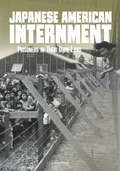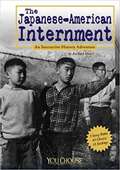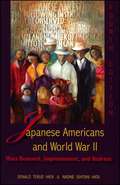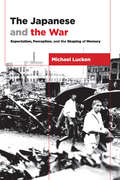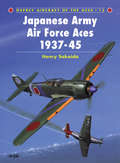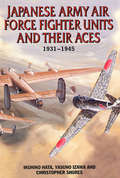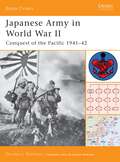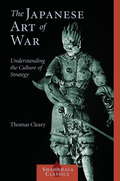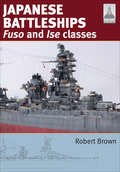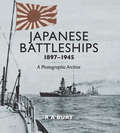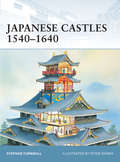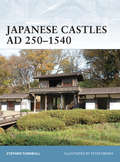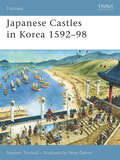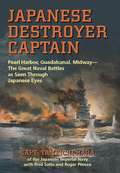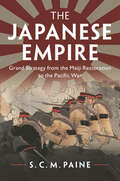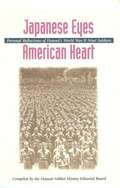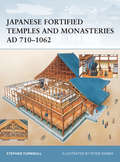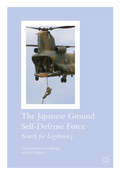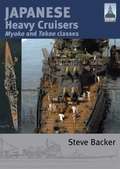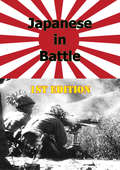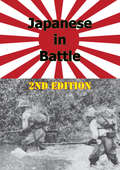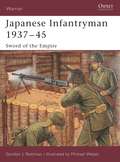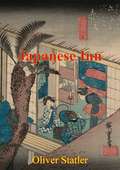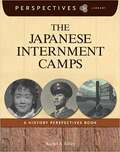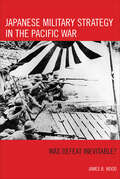- Table View
- List View
Japanese American Internment: Prisoners in Their Own Land (Tangled History)
by Steven OtfinoskiVivid storytelling brings World War II history to life and place readers in the shoes of the people who experienced the United States' Japanese internment camps. On the heels of Japan's surprise attack on Pearl Harbor in December 1941, President Franklin D. Roosevelt issued Executive Order 9066. Through this order, more than 110,000 people of Japanese descent, many of them U.S. citizens, were forced to relocate to military camps for the duration of the war. Suspenseful, dramatic events unfold in chronological, interwoven stories from the different perspectives of people who experienced these events while they were happening. Narratives intertwine to create a breathless, "What's Next?" kind of read. Students gain a new perspective on historical figures as they learn about real people struggling to decide how best to act in a given moment.
The Japanese-American Internment: An Interactive History Adventure (Understanding Differences Series)
by Lola M. Schaefer Rachael HanelDescribes the events surrounding the internment of Japanese Americans in relocation centers during World War II. <P><P>The reader's choices reveal the historical details from the perspective of Japanese internees and Caucasians.
Japanese Americans and World War II: Mass Removal, Imprisonment, and Redress
by Donald Teruo Hata Nadine Ishitani HataLike its predecessors, this fourth edition of "Japanese Americans and World War II" is intended as a succinct and affordable supplement to history and political science texts that minimize or neglect the "Nikkei" (Japanese American) experience in World War II. As was hoped, the first two editions of this publication found an enthusiastic reception by instructors and students alike at the high school, community college, and university level. In addition, the expanded third edition found a new readership beyond the classroom, in members of and visitors to museums, such as the Japanese American Museum in Los Angeles, and interpretive centers at former concentration camp sites administered by the National Park Service at Manzanar, Tule Lake, and others (some in progress). In response to the supportive and constructive feedback of students, instructors, and lay readers, we at Harlan Davidson undertook a bold and sweeping redesign of the third edition that saw our well-loved little "pamphlet" become an attractive but still highly affordable book that, in addition to taking the narrative completely up to date, has been thoroughly re-edited and expanded further to include photographs, key documents, and an enhanced multidisciplinary bibliography of 200 core publications by historians, political scientists, sociologists, anthropologists, and others, as well as multimedia and Internet-based sources. Inaccurate and misleading euphemisms such as "evacuation" and "internment" have been meticulously replaced with more accurate terms like "mass removal" and "imprisonment--changes explained and amplified in a new "Note on Terminology," which explains the movement to correct long out-dated language and refers readers to thoughtful essays on the subject by eminent scholars.
The Japanese and the War: Expectation, Perception, and the Shaping of Memory (Asia Perspectives: History, Society, and Culture)
by Michael LuckenMemories of World War II exert a powerful influence over Japan's culture and society. In The Japanese and the War, Michael Lucken details how World War II manifested in the literature, art, film, funerary practices, and education reform of the time. Concentrating on the years immediately before and after (1937 to 1952), Lucken explores the creation of an idea of Japanese identity that still resonates in everything from soap operas to the response to the Fukushima nuclear disaster.Lucken defines three distinct layers of Japan's memory of World War II: the population's expectations at the beginning, the trauma caused by conflict and defeat, and the politics of memory that arose after Japan lost to the Allied powers. Emphasizing Japanese-language sources, Lucken writes a narrative of the making of Japanese cultural memory that moves away from Western historical modes and perspectives. His approach also paints a new portrait of the U.S. occupation, while still maintaining a cultural focus. Lucken sets out to capture the many ways people engage with war, but particularly the full range of Japan's experiences, which, he argues, the Japanese state has yet to fully confront, leading to a range of tensions at home and abroad.
Japanese Army Air Force Aces 1937 - 45
by Henry SakaidaLittle has been published in English on the Japanese Army Air Force (JAAF), let alone its most successful fighter pilots - no less than 150 of them achieved ace status during eight years of near-constant war, and they are all listed in this volume. From the arid plains of the Mongolian border region to the lush jungles of New Guinea, the JAAF was more than a match for the many opponents it fought against for control of the skies. Indeed, even when the mighty Allied war machine proved almost overwhelming from early 1944 onwards, the elite fighter pilots of the various sentais within the JAAF fought on with near-fanatical loyalty in defence of the Home Islands.
Japanese Army Air Force Units and Their Aces, 1931–1945: 1931-1945
by Christopher Shores Yasuho Izawa Ikuhiko HataAn extensive guide to Japan&’s Army Air Force Units and their ace pilots during conflicts in the 1930s and &‘40s, now in English. Commencing with a detailed study of the development, equipment, and operations flown by this force since its inception immediately after the end of World War I, until the catastrophic conclusion of World War II, the initial section deals with the wars in China and Manchuria, as well as the Pacific War of 1941-1945. The second section explores the history of each unit, listing the types of aircraft used, the bases from which they flew, and the unit and formation commanders. Notable mission details are also included. Finally, the third section offers biographical notes for notable fighter pilots and features supporting listings and a glossary of Japanese terms. Photographs of pilots and aircraft are also included, along with line drawings indicating the unit markings carried. This revised edition is a companion volume to Japanese Naval Air Force Fighter Units and Their Aces, 1932–1945.
Japanese Army in World War II
by Gordon RottmanThe Japanese conquest of the Pacific comprised of a complex series of widely scattered operations; their intent was to neutralize American, Commonwealth, and Dutch forces, seize regions rich in economic resources, and secure an outer defense line for their empire. Although their conquest was successful, the forces deployed from Japan and China were not always ideally trained, equipped and armed. The South Seas and tropics proved challenging to these soldiers who were used to milder climates, and they were a less lethal enemy on the Chinese mainland. This book examines the overall structure of the Imperial Japanese Army (IJA), the forces in existence at the beginning of World War II and the organization of the forces committed to the conquest of the Pacific.
The Japanese Art of War: Understanding the Culture of Strategy
by Thomas ClearyMilitary rule and the martial tradition of the samurai dominated Japanese culture for more than eight hundred years. According to Thomas Cleary--translator of more than thirty-five classics of Asian philosophy--the Japanese people have been so steeped in the way of the warrior that some of the manners and mentality of this outlook remain embedded in their individual and collective consciousness. Cleary shows how well-known attributes such as the reserve and mystery of formal Japanese behavior are deeply rooted in the ancient strategies of the traditional arts of war. Citing original Japanese sources that are popular among Japanese readers today, he reveals the hidden forces behind Japanese attitudes and conduct in political, business, social, and personal life.
Japanese Battleships: Fuso & Ise Classes (Shipcraft Ser. #24)
by Robert BrownThe 'ShipCraft' series provides in-depth information about building and modifying model kits of famous warship types. Lavishly illustrated, each book takes the modeler through a brief history of the subject class, highlighting differences between sisterships and changes in their appearance over their careers. This includes paint schemes and camouflage, featuring color profiles and highly-detailed line drawings and scale plans. The modeling section reviews the strengths and weaknesses of available kits, lists commercial accessory sets for super-detailing of the ships, and provides hints on modifying and improving the basic kit. This is followed by an extensive photographic survey of selected high-quality models in a variety of scales, and the book concludes with a section on research references—books, monographs, large-scale plans and relevant websites. This volume covers the two related classes of Japanese 14in-gunned battleships, originally built during the First World War but subsequently totally reconstructed. They are famous for the towering forward superstructure, usually described as a pagoda bridge, that they featured when rebuilt. Ise and Hyuga underwent further reconstruction during the Second World War to emerge as a unique hybrid of battleship and aircraft carrier in a desperate attempt to compensate for fleet carriers sunk earlier in the war.
Japanese Battleships, 1897-1945: A Photographic Archive
by R.A. BurtRare images of the Imperial Japanese Navy&’s fleet before it was almost completely destroyed in World War II. This photographic archive contains some 125 stunning images of the battleships of the Imperial Japanese Navy, many unfamiliar, some very rare. They constitute an archive that is pretty much without equal in publications in the West. The period covered is from the launch of Japan's first real contemporary battleship, Yashima, built by Armstrong&’s on the Tyne, up to the final destruction of her fleet in the Pacific in 1945. During that time Japan built up the third largest navy in the world and, before the First World War, it was Britain that armed her at sea. All her dreadnoughts saw action in the Second World War, and of all these numerous ships only Nagato survived the conflict. She was to become a target in the Bikini A-bomb tests in 1946. Just as the ships were lost, so were the majority of photographic records, and relatively few images have come down to us. This selection from R.A. Burt's archive represents therefore a remarkable portrayal of these ships. Extended captions and ship specifications enhance its reference value, making it an essential volume for enthusiasts, modelers, and anyone with an interest in the Second World War.
Japanese Castles 1540-1640
by Stephen Turnbull Peter DennisThe landscape of 16th- and 17th-century Japan was dominated by the graceful and imposing castles constructed by the powerful 'daimyo' of the period. In this the most turbulent era in Japanese history, these militarily sophisticated structures provided strongholds for the consolidation and control of territory, and inevitably they became the focus for many of the great sieges of Japanese history: Nagashino (1575), Kitanosho (1583), Odawara (1590), Fushimi (1600), Osaka (1615) and Hara (1638), the last of the battles that brought an end to a period of intense civil war. This title traces their development from the earliest timber stockades to the immense structures that dominated the great centres of Osaka and Edo.From the Trade Paperback edition.
Japanese Castles AD 250-1540
by Stephen TurnbullDr Stephen Turnbull is internationally recognised for his research into and writing on Japanese military history. Here he applies his scholarship to an account of the evolution of Japanese defensive architecture and engineering, from early earthworks through to wooden and earth castles and, finally, the emergence of the stone towers that are so characteristic of the samurai. He also plots the adaptation of Japanese castles to accommodate the introduction of firearms. With unpublished photographs from the author's private collection and full-colour artwork, including detailed cutaways, this is an essential guide to the fascinating development of Japanese castles.
Japanese Castles in Korea 1592-98
by Stephan TurnbullThe Japanese invasion and occupation of Korea, which lasted from 1592 to 1598, was the only occasion in Japanese history when samurai aggression was turned against a foreign country. During the occupation of Korea the Japanese built 25 wajo or castles. Unlike the castles built in Japan, these castles were never developed or modernized after the Japanese departure meaning that the details of late 16th century castle construction are better preserved than at many other sites. Written by Stephen Turnbull, an expert on the subject, this book examines the castles built by the Japanese in Korea, as well as the use the samurai made of existing Korean fortifications, particularly city walls. This resulted in curious hybrid fortifications which dominated the landscape until the Japanese were pushed out of the peninsula by a furious onslaught from the huge Chinese armies.
Japanese Destroyer Captain
by Roger Pineau Fred Saito Tameichi HaraThis highly regarded war memoir was a best seller in both Japan and the United States during the 1960s and has long been treasured by historians for its insights into the Japanese side of the surface war in the Pacific. The author was a survivor of more than one hundred sorties against the Allies and was known throughout Japan as the Unsinkable Captain. A hero to his countrymen, Capt. Hara exemplified the best in Japanese surface commanders: highly skilled, hard driving, and aggressive. Moreover, he maintained a code of honor worthy of his samurai grandfather, and, as readers of this book have come to appreciate, he was as free with praise for American courage and resourcefulness as he was critical of himself and his senior commanders.
The Japanese Empire
by Paine S. C. M.The Japanese experience of war from the late-nineteenth to the mid-twentieth century presents a stunning example of the meteoric rise and shattering fall of a great power. As Japan modernized and became the one non-European great power, its leaders concluded that an empire on the Asian mainland required the containment of Russia. Japan won the First Sino-Japanese War (1894-5) and the Russo-Japanese War (1904-5) but became overextended in the Second Sino-Japanese War (1931-45), which escalated, with profound consequences, into World War II. A combination of incomplete institution building, an increasingly lethal international environment, a skewed balance between civil and military authority, and a misunderstanding of geopolitics explains these divergent outcomes. This analytical survey examines themes including the development of Japanese institutions, diversity of opinion within the government, domestic politics, Japanese foreign policy and China's anti-Japanese responses. It is an essential guide for those interested in history, politics and international relations.
Japanese Eyes American Heart: Personal Reflections of Hawaii's World War II Nisei Soldiers
by Hawaii Nikkei History Editorial Board Tendai Education Foundation StaffJapan's attack on Pearl Harbor on December 7, 1941, set Hawaii on a new course of history that would affect every living soul in these Islands. How Hawaii's people, particularly those of Japanese ancestry, responded to the act of aggression by Japan changed Hawaii's social, economic, and political history forever. Much has been written about how Americans of Japanese ancestry (AJA) in the 100th Infantry Battalion, 442nd Regimental Combat Team, Military Intelligence Service, and the 1399th Engineer Construction Battalion answered their country's call through military service--and the high price they paid in human lives in freedom's cause. The history has been recorded, the battles documented, the medals tallied, the social and political legacy articulated and applauded. Not as thoroughly recorded, however, are the thoughts and innermost feelings of the nisei soldiers who put their lives on the line for their country, and what those experiences meant to them. Those stories have always been the most difficult to pry from the hearts and souls of the AJA men who served our country in World War II. It was that void in the story of Hawaii's nisei soldiers that Bishop Ryokan Ara of the Tendai Educational Foundation asked members of the Hawaii Nikkei History Editorial Board to fill. Japanese Eyes... American Heart is the result of that effort. It is a rare and powerful collection of personal thoughts written by the soldiers themselves, reflections of the men's thoughts as recorded in diaries and letters sent home to family members and friends, and other expressions about an episode that marked a turning point in the lives of many.
Japanese Fortified Temples and Monasteries AD 710-1062
by Stephen TurnbullFrom the 10th century onwards the great Japanese monastic foundations of Nara and Mount Hiei maintained large armies of warlike monks. The tempestuous political rivalries that developed between the different orders of monks and religiously inspired laymen ensured that their temples and monasteries had to be securely sited and robustly defended. This books recreates these enormous fortified monasteries and temples, tracing their development from the 10th century through to the Sengoku Jidai period and the rise of the power of the shogunate under Tokugawa Ieyasu.
The Japanese Ground Self-Defense Force
by Robert D. Eldridge Paul MidfordBased on extensive Japanese-language materials, this book is the first to examine the development of Japan's Ground Self-Defense Force. It addresses: how the GSDF was able to emerge as the post-war successor of the Imperial Japanese Army despite Japan's anti-militarist constitution; how the GSDF, despite the public skepticism and even hostility that greeted its creation, built domestic and international legitimacy; and how the GSDF has responded to changes in international and domestic environments. This path-breaking study of the world's third-largest-economic power's ground army is timely for two reasons. First, the resurgence of tensions in Northeast Asia over territorial disputes, and the emphasis recent Japanese governments have placed on using the GSDF for defending Japan's outlying islands is driving media coverage and specialist interest in the GSDF. Second, the March 11, 2011 Great East Japan Earthquake and Tsunami has focused global attention on the GSDF as Japan's lead disaster relief organization. This highly informative and thoroughly researched book provides insight for policy makers and academics interested in Japanese foreign and defense policies.
Japanese Heavy Cruisers: Myoko and Takao Classes (Shipcraft Ser. #Vol. 5)
by Steve BackerThe ShipCraft series provides in-depth information about building and modifying model kits of famous warship types. Lavishly illustrated, each book takes the modeller through a brief history of the subject class, highlighting differences between sister-ships and changes in their appearance over their careers. This includes paint schemes and camouflage, featuring colour profiles and highly-detailed line drawings and scale plans. The modelling section reviews the strengths and weaknesses of available kits, lists commercial accessory sets for super-detailing of the ships, and provides hints on modifying and improving the basic kit. This is followed by an extensive photographic gallery of selected high-quality models in a variety of scales, and the book concludes with a section on research references books, monographs, large-scale plans and relevant websites.rnrnThis volume is devoted to the largest cruisers in the Imperial Japanese Navy. Built in defiance of treaty restrictions, they were the fastest and most powerful heavy cruisers of their day, and were heavily engaged in every campaign from Pearl Harbor to the end of the Pacific War.
JAPANESE IN BATTLE 1st Edition [Illustrated Edition] (JAPANESE IN BATTLE #1)
by Military Intelligence Staff GHQ IndiaIllustrated with more than 20 maps plans and photos.When this handbook was written in 1943 the Japanese soldier was seen by British Empire troops as a jungle fighting superman, who had largely blitzed and defeated them at every turn. As part of an effort to dispel this myth the Intelligence Section of General Headquarters in India set about distilling the tactics that the Japanese had used and to formulate counter-measures. As the staff point out in their introduction;"The Japanese are an island race who have mastered the art of war, not through any mysterious or indefinable quality inherited from their Emperor, their islands, or their ancestors during your grandfather's time they were still in the bow-and-arrow stage-but through serious study of ancient and modern methods, and by intensive training. If we analyse their tactics, reducing them to fundamentals, all that they practise is to be found in our own training manuals, or in the military histories of ancient campaigns; not even the snipers in the trees are new-the jungle tribes of Africa and Brazil have employed them since time immemorial."In their long history the peoples of our Empire have shown the world that they possess more than an average share of courage and tenacity, and today we must add to these advantages our undoubted superiority in arms and equipment. Any success which the Japanese have had against us was due to intensive training, carefully rehearsed plans and normal guts. Whatever the task in hand-be it the digging of a single fox-hole or the preparation of a large-scale invasion-their work is done with meticulous care, and by intensive and sustained training alone can we hope to outmanoeuvre them."As close to a handbook in English of how the Japanese fought and won their battles in the jungles of Southeast Asia at the beginning of the Second World War: A fascinating read.
JAPANESE IN BATTLE 2nd Edition [Illustrated Edition] (JAPANESE IN BATTLE #2)
by Military Intelligence Staff GHQ IndiaIllustrated with more than 30 maps plans and photos.Written in August 1944 when the Japanese Imperial armies had tasted their first bitter defeats in Burma; the staff of GHQ India were determined to record all of the lessons learned and ensure that the troops in the field would profit from the knowledge. A brilliant exposition of the Japanese methods of land warfare in the later stages of the Second World War as can be found.Although titled as a second edition, this World War Two briefing book is in fact almost completely different from the first Edition.
Japanese Infantryman 1937-45
by Gordon Rottman Michael WelplyThis book examines in detail the Japanese Infantryman who was, despite comparisons with the notorious German Waffen SS of World War II (1939-1945), an enigma to Westerners. Brutal in its treatment of prisoners as well as the inhabitants of the areas that it conquered, the Imperial Japanese Army also had exacting standards for its own men - strict codes of honor compelled Japanese soldiers to fight to the death against the more technologically advanced Allies. Identifying the ways in which the Japanese soldier differed from his Western counterpart, the author explores concepts such as Bushido, Seppuku, Shiki and Hakko Ichi-u in order to understand what motivated Japanese warriors.
Japanese Inn: A Reconstruction Of The Past
by Oliver StatlerThe beguiling story of the Minaguchi-ya, an ancient inn on the Tokaido Road, founded on the eve of the establishment of the Tokugawa shogunate. Travellers and guests flow into and past the inn -- warriors on the march, lovers fleeing to a new life, pilgrims on their merry expeditions, great men going to and from the capital. The story of the Minaguchi-ya is a social history of Japan through 400 years, a ringside seat to some of the most stirring events of a stirring period.'Statler has created a strangely beautiful book that succeeds in conveying intact not only a great deal of its history but the mood of that land. The result is sheer delight. Japanese Inn is the work of a master craftsman; it is so well conceived that the narrative moves from past to present in the same paragraph without the slightest confusion to the reader; it is so well written that only in retrospect is one aware of its remarkable flawless style. Through the author's particular magic, the stories unfold as one narrative, as beautifully and memorably as the unrolling of a long Japanese scroll.'--CURT GENTRY'The reader learns much of Japan's past -- and, as is inevitable in a study of that country, of present-day Japanese as well. Mr Statler's prose succeeds in evoking the pageantry of the past in the brilliant color of the kabuki stage. Nothing seems to have been overlooked by the author. Mr Statler's book is Japanese history made easy, and grand entertainment.'-- NEW YORK TIMES BOOK REVIEW'Much of it is told in fictional form. Some of the episodes have come out of family annals and memories, some from the records of the temple; some are imagined; but all could have happened ... Mr Statler has told the story vividly and with sympathy. It moves. It has the authentic feel of Japan.'--INTERNATIONAL HERALD TRIBUNE
The Japanese Internment Camps: A History Perspectives Book (Perspectives Library)
by Rachel A. BaileyThis book relays the factual details of the Japanese internment camps in the United States during World War II. The narrative provides multiple accounts of the event, and readers learn details through the point of view of a child at an internment camp, a Japanese-American soldier, and a worker at the Manzanar War Relocation Center. The text offers opportunities to compare and contrast various perspectives in the text while gathering and analyzing information about a historical event.
Japanese Military Strategy in the Pacific War: Was Defeat Inevitable?
by James B WoodIn this provocative history, James B. Wood challenges the received wisdom that Japan's defeat in the Pacific was historically inevitable. He argues instead that it was only when the Japanese military prematurely abandoned its original sound strategic plan—to secure the resources Japan needed and establish a viable defensible perimeter for the Empire—that the Allies were able to regain the initiative and lock Japanese forces into a war of attrition they were not prepared to fight. The book persuasively shows how the Japanese army and navy had both the opportunity and the capability to have fought a different and more successful war in the Pacific that could have influenced the course and outcome of World War II. It is therefore a study both of Japanese defeat and of what was needed to achieve a potential Japanese victory, or at the very least, to avoid total ruin. Wood's argument does not depend on signal individual historical events or dramatic accidents. Instead it examines how familiar events could have b
